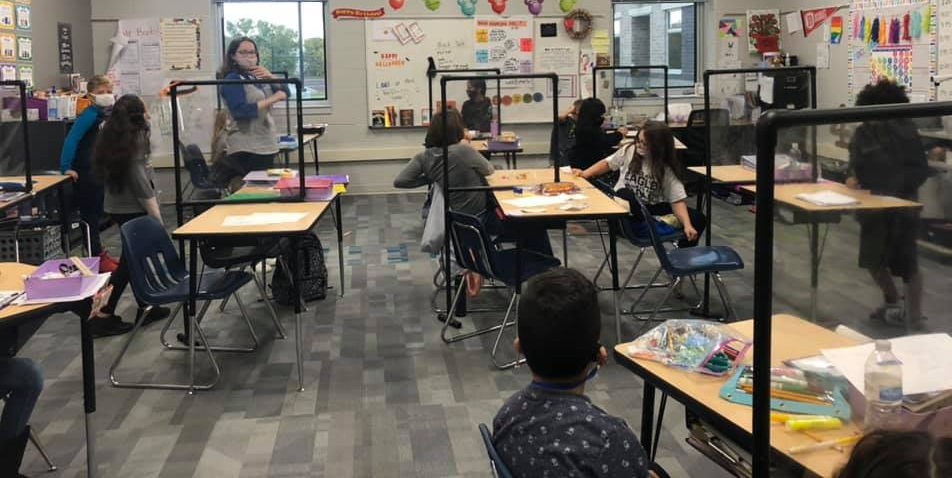Why were QPS/QFT contract talks so amicable this time? Millions in stimulus money certainly helped, and more is coming

QUINCY — Sayeed Ali, president of the Quincy School Board, and Brandi Many, the teacher subgroup president of the Quincy Federation of Teachers and Educational Support Personnel, noted how easy recent contract negotiations were. Only three bargaining sessions were needed to reach a deal well before the June 30 contract expiration date.
When the last contract was negotiated in 2017, the teachers’ union had voted to strike and the school district was coming off three consecutive years of deficit budgets, leading to some contentious moments.
A little stimulus money certainly helped this year’s process, and even more is on the way.
Figures provided by the Illinois State Board of Education show that the Quincy School District has received approximately $8.6 million from two allocations of federal money this year. Superintendent Roy Webb expects a third allocation of more than $15 million is to arrive this summer.
“No one’s ever going to sit there and go, ‘Oh, yay, pandemic. You’ve saved us all this money,’” Webb said. “I would never call this year a benefit in any way, but the truth of the matter is it helped fiscally speaking. (The stimulus money) helped stabilize our finances with regard to paying some positions, and it has allowed us to build up our fund balances.”
‘Able to take some risk’ with teacher contract
The School Board and the teachers’ union agreed Wednesday on a one-year contract that called for a three percent increase in salary for all union employees, along with the School District paying one percent of the employee share going into the Teacher Retirement System and a half-percent of the employee share of the Illinois Municipal Retirement Fund.
The increases in salary and benefits, combined with a change in insurance costs, created an additional net cost of $1.12 million to the school district.
“We were able to take some risk (with the teacher contract),” Webb said. “Because of these federal stimulus dollars, we were in a lot different shape than what we would have been otherwise. It would have been a more difficult bargaining session.”
Webb believes the new contract rewards the teachers and support personnel for helping Quincy be one of the few school districts its size to stay open for 181 days in the 2021-22 school year.
“We felt it was the right thing to do for our staff, and it also keeps us more competitive,” he said. “We also have to meet the legal requirements of a $40,000 minimum teacher salary and a $15 minimum wage, so we had to ramp up what we’re paying whether we wanted to or not. This is just allowing us to do that without making cuts.”
Quincy voters rejected a 53-cent increase in the education fund in March 2020 that would have generated an estimated $3 million a year. Webb thought the school district would be operating in a deficit budget when the 2021-22 school year began.
Stimulus money coming in three bills
The CARES Act, also known as the Coronavirus Aid, Relief, and Economic Security Act, was a $2.2 trillion economic stimulus bill signed into law on March 27, 2020. It included $13.2 billion for the Elementary and Secondary Schools Emergency Relief (ESSER) fund to help K-12 schools respond to impacts of COVID-19. The Quincy School District received $1,795,050 in ESSER funds.
“(ESSER) money was really for school safety,” Webb said. “We purchased masks for kids and teachers and principals. We rented tents. We had clear plastic barricades made between students. There was a lot of overtime and extra cleaning, spraying down lunchrooms and stuff like that.”
The clear plastic barricades were removed from classrooms by the end of February.
Quincy Notre Dame also received $67,309 of that money, which was based upon the number of students in the school receiving free and reduced lunches.
Webb said some ESSER funds were used to pay some instructional coaches and interventionist teachers, stabilizing the budget.
The CRRSA Act, also known as the Coronavirus Response and Relief Supplemental Appropriations Act, was a $2.3 trillion spending bill signed into law on Dec. 27, 2020. It included $53.4 billion for the Elementary and Secondary School Emergency Relief (ESSER II) fund for COVID-19 response efforts. The Quincy School District received $6,815,484 in ESSER II funds.
“(ESSER II money) was earmarked for the reopening of your school, but we never closed our school,” Webb said. “We never stopped teaching in person. All of those things that the first pool of money was spent on — the shields, the tents, the dividers, everything else — we had already purchased, while other schools were scrambling to open.”
Webb said money was spent on technology to make Quincy a one-to-one district (each student in the school district now has one computer device). Quincy was a one-to-two district last year.
The district also paid for student support family liaisons who work with families and help maintain discipline. Webb said the entire tech department was paid for with stimulus money this year. Money also was saved with the cancellation of field trips and reduction in the number of athletic events that QHS teams traveled to this year.
The American Rescue Plan Act of 2021, also called the COVID-19 Stimulus Package, was a $1.9 trillion spending bill signed into law on March 11, 2021. It included $122 billion for the Elementary and Secondary School Emergency Relief (ESSER III) fund to help educational agencies and school districts safely reopen, sustain safe operation and address the impact of the pandemic on the nation’s students. The Quincy School District will receive $15,299,208.
“We’re still going to safety first,” Webb said of the latest installment of money. “Then we’re going to make sure our finances are stable. I’m sure we will get some guidance on what we can spend that money on, but that hasn’t been communicated with us yet.”
Pritzker hopes to fully fund state’s education system
Webb says the school district’s rainy day fund is “a lot smaller than what it should be.” He would like to get it up to half of the district’s annual budget. This year’s budget is $66 million, and he would like $33 million in reserve. As of Thursday, Webb said the district had $12 million in the education fund, $3 million in the building fund, $1 million in the transportation fund and $5 million in working cash for a total of $21 million.
“We’re still concerned about our spending,” Webb said. “Outside of that stimulus money, we would have been in deficit spending, and, and this is not something that we can depend on every year.”
Gov. J.B. Pritzker announced earlier this month he would revise a $41.6 billion budget proposal to include an additional $350 million for education. Pritzker said the state could afford to fully fund the state’s education system as called for by the state’s evidence-based funding formula adopted by lawmakers in 2017.
The Quincy School District appears to be on solid financial ground for the first time in many years. It could remain that way for a while.
“But it’s still an education world, and I still live in Illinois,” Webb said with a smirk.
Miss Clipping Out Stories to Save for Later?
Click the Purchase Story button below to order a print of this story. We will print it for you on matte photo paper to keep forever.

